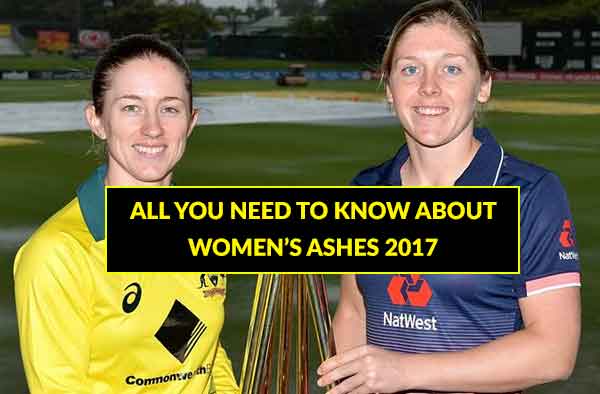“For too long, women have been kept beyond the boundary. Now they are storming in the field”………..Isabelle Duncan (Skirting the Boundary: A History of Women’s Cricket).

True. There was a yawning gap because of the omission of women from the game. Described ‘unconventional’ by the orthodox, women of England took the game in the late 18th century, which was fostered by the ‘new women’ in the 19th century. Then on the highs and lows of the 19th and 20th centuries, culminating in the contemporary superstars dominating world cricket, women cricket became professional. Like their men counterpart, the rivalry between England and Aussie Women grew bigger due to the time. Started in 1934, the rivalry officially came to be known as ‘Women Ashes’ in 1998, when a ceremony took place in the Harris Gardens at Lord’s. After the match, a miniature bat signed by the players of both the team, a copy of WCA constitution and rules book were consigned to the flames and the ashes were sealed in a trophy, made of 300 years old English Yew tree, to be known henceforth as ‘the ashes.’ Most importantly it also marked the dissolution of the Women Cricket Association formed in 1926. Now the ‘Ashes’ went through several developments within itself. From three day test to five day test and from ‘Ashes’ containing only test match series to recent point system Ashes where all three formats are taken into account to decide the winner of the Ashes.
Wanting to play each other Australia invited WCA to play them in 1934.But as money was at stake the English women cricketers had to work hard to raise money to meet their personal expenses in Australia. Led by Betty Archdale, English women reached the down-under. But what was important in their voyage was that they even played cricket in the deck of the ship with men and even in the places like Bombay and Ceylon. From the diary of British reserve wicket keeper Grace Morgan we came to knew that the matches were played in packed ground. “I have never so many spectators at a women’s match before. Native packed the ground.” – she said.
England destroyed Australia (2-0) in the 3 match test series. Played in Brisbane, Sidney and Melbourne England won the first two test matches while Australia fought well to save the thirds test match. These were three day test matches and several players came into limelight after these series. Myrtle Maclagan of England with her slow spin bowling helped England to win the first test by 9 wickets. Her 7/10 and 72 with bat in first test continued in the 2nd test as well where her 119(first century in Women Test) guided her team to clinch victory by 8 wickets. Another interesting thing occurred in the first test. One of three Shevill sisters of Australia, Essie Shevill pointed out to be the designer of ‘helmet’ by cobbling albeit together. From the Australian point of view Peggy Antonio, called ‘Girl Grimmett’ by the press , with her leg spin tried to turn the tide by 6/49 in the first innings of the third test but unable to win it for her side. But it is said that Antonio who dominated 1930’s, showcased the glimpses of her talent in this series.
In the return visit to England in 1937, Australia was determined to clinch the series. Under Margaret Paden, and strict code of conduct enforced, Aussies tried to match their British counterpart. Peggy Antonio, who came under the lenses of scrutiny in the series of 1934 , this time led to win the first match, despite the heroic of Maclagan with the bat. The 2nd test witnessed the few records to be made by both the sides. Maclagan hit 115, the first female cricketer to score a century in the English soil. Peggy Antonio and Keeper Alice Wegemund both made the records in the Blackpool test but failed to save the test. Keeper took record number of dismissal in an innings(7). The 3rd test, despite bad weather, was a cracker of a match. 7000 spectetors , most of them were sceptical about women cricketers, said , “ ……. but by Jove, they can play.”

Ended in a draw, the test series saw the evenly matched teams competed in that, before the World War II stared and cricket was put to a halt.
The post-war rivalry between these two cricketing power resumed in 1948 and this was time when the Australian women rose to the occasion as several renowned players played for the team. This was the series that depicted the emergencies of Betty Wilson. England lost the first test match by 186 runs and the pioneer was Betty Wilson who hit century and took 6 wickets for just 23 runs. Saved the 2nd test match due to the brilliant batting display by Moly Hide and Myrtle Maclagan in the fourth innings, England was determined to retain the Ashes. In the last test match Moly Hide’s 124, which earned her the name of ‘Lady Denis Compton’ by Neville Cardus, failed to win the test match and level the series. For the first time Australia won the women ‘Ashes’ and it was truly the series of Australia.
The journey which started with various adversities , was on the road to thrive in the later period. In the year between 50’s and 80’s the women “Ashes’ grew bigger and bigger. England drew several series in 1951(1-1) and in the latter half of the 50’s they drew a four test match series (0-0) due to the shortage of time. So this was the time when the prospect of 4 days test match came in the play. 50’s also the time when the world saw the rise of Mary Duggan. This prolific English All rounder was very much instrumental for at least one decade, as England didn’t lose any of their 14 test matches in the sixties. 1963 was the last time appeared in the white for England and she left with the bang. Her terrific 101 and 7 wickets led England to win the series by 1-0 and eventually that series was turned out to be their last win against the Aussies for 42 years. As one legend left the field another was there to take her place in the England side and it was Rachel Heyhoe (Flint).Ashes of 1966 witnessed another draw (0-0) where Flint torn apart the Aussie attack throughout the series.
As the years past by One day international also made their appearance in the ‘Ashes’ series. In 1976 first ODI was played in the Women Ashes series. ODI cricket was a new phenomenon that time and England took the upper hand by winning the series by 2-1. In the test series, rainy Old Trafford provided the perfect condition for the seamer. But any result want possible because of the frequent intervention of the rain. Next test match saw the run fest and Margaret Jennings of Australia though scored the century it was their all time slowest till then. 3rd test was a history in itself as for the first time four day was organized for the women in white. The fate of the match didn’t change at all from the previous encounters, and the Oval Test and the series was drawn.(0-0)
1984 ‘Ashes’ was the Golden Jubilee of the Women Ashes. And that series saw the historic turn around. After the 3 test matches Australia was trailing by 0-1.
246 was needed for the English women to seal the test match and series. But in utter surprise the home team won the match by 117 runs and none apart from Jane Brittin (65) made useful contribution for the team. Spirited Aussies continued their momentum in the last test match as well in Victoria as well and crushed the opponent by 7 wickets. Australia’s victory was significant in many terms. It was their first ‘Ashes’ Victory after 1948 and they won two test matches in the series for the first time.
The 90’s were the predominantly the Australia’s year as per the Ashes is concerned. The first Ashes of the new millennium continued to depict the same old story for quite some time as they were thrashed 4-0 in the ODI series in 2000. In the next ashes series of 2 test matches England was again defeated by 2-0 but the silver-lining was the rise of the future stars. In the first test match Debutant Michelle Goszko hit 204 highest by a debutant till now and the highest test innings by women. Flitzpatrick rattled the opponent by her fifer and won the match by an innings and 140 runs. Magical Flitzpatrick nabbed another 5 wicket haul and her teammate Karen Rolton hit the highest individual run of 209 in a test innings breaking the record of Goszko. This record was eventually broken by Mithali Raj in 2002 when she scored 214 against England. Second test was by 9 wickets by the Australia. 2005 Ashes was a cracker one like their men counterpart. Though the number of the test matched reduced after ICC overtook the International Women Cricket Association , England defeated the Aussies by 6 wicket in one-off test match as newbie Katherine Brunt became player of the match. 2005 ODI series was worth of watching, England levelled the series by winning consecutive matches . The last match was at stake for both the side as England had not won ODI series against AUS since 1993. Flitzpatrick snatched a 4 run victory with a three ball to spare. Winning the ODI 3-2, T-20 series was won by the women in coloured of Australia as their veteran star Karen Rolton made 96 of 53 balls. The Ashes later on like in 2007 , 2009 and 2010/11 was respectively won by Australia , England and Australia.
The Ashes which took a different point based structure after 2011. 2013 and 2015 missed point based ashes series was won by the ‘Three Lions’ and 2013/14 was won by the ‘Southern Stars’. But in the discussion till now , the journey of the Ashes itself history, with so many ups and downs for the both the team and the comeback of them. The ‘urn’ in which the Ashes said to have been kept witnessed many history to be made and many records to be broken and many stars to rise and many to fall apart. But unlike the stars may it be Peggy Antonio or may it be Charlotte Edwards , who came and won and left the ground , the ‘Ashes in the Urn’ stands eternal and watching this glorious game of cricket which not more a means of masculinity. The ‘Ashes in the Urn’ witnessed the chances and evolutions of the game within itself and it is doing the same as 2017 will saw the first women Day-night Ashes test match , and hopefully the ‘Ashes in the Urn will continue to do so till the doom of the Earth.